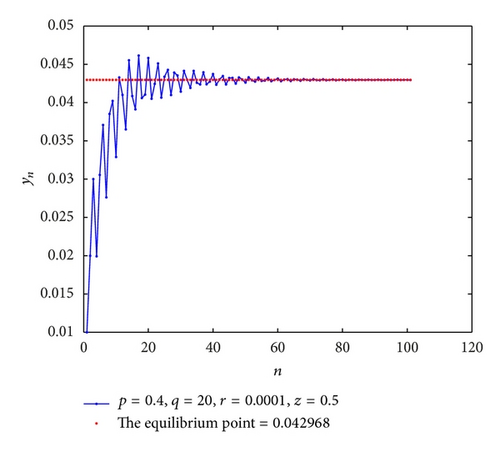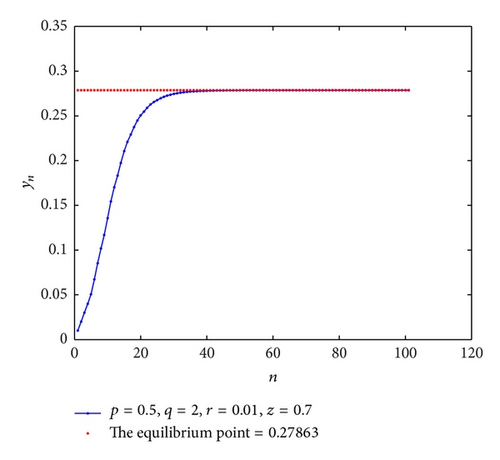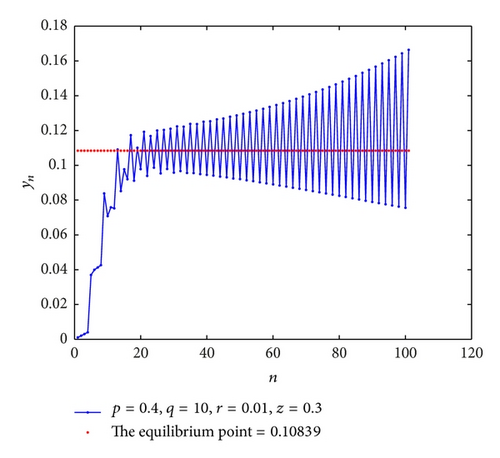On the Period-Two Cycles of xn+1 = (α + βxn + γxn−k)/(A + Bxn + Cxn−k)
Abstract
We consider the higher order nonlinear rational difference equation xn+1 = (α + βxn + γxn−k)/(A + Bxn + Cxn−k), n = 0,1, 2, … , where the parameters α, β, γ, A, B, C are positive real numbers and the initial conditions x−k, …, x−1, x0 are nonnegative real numbers, k ∈ {1,2, …}. We give a necessary and sufficient condition for the equation to have a prime period-two solution. We show that the period-two solution of the equation is locally asymptotically stable.
1. Introduction
Recently, dynamics of nonnegative solutions of higher order rational difference equation has been an area of intense interest. Related to this subject, researches are done by Dehghan et al. [1–4], Zayed [5–7], Huang and Knopf [8, 9], Karatas [10, 11], and others. For the general theory of difference equations, one can refer to the monographes of Kocić and Ladas [12], Elaydi [13], Agarwal [14], Kulenović and Ladas [15], and Camouzis and Ladas [16]. Other related results can be found in [17–24].
The periodic character of positive solutions of (1) for k = 1 has been investigated by the authors in [25]. They showed that the period-two solution of (1) for k = 1 is locally asymptotically stable if it exists.
Motivated by the above results, our interest is now to study and generalize the previous results to the general case depicted in (1).
This paper is organized besides this introduction in three sections. In Section 2, we present some preliminaries and some results which can be mainly deduced from the general situation studied in [12–16, 26]. Our main results are presented in Section 3; we give a necessary and sufficient condition for the equation to have a prime period-two solution, in addition to providing a necessary and sufficient conditions for the prime period-two solution of the equation to be locally asymptotically stable. In order to illustrate the results of the previous section and to support our theoretical discussion, we consider several numerical examples in Section 4; we use MATLAB to see how the behaviors of (1) look like. Finally, we conclude in Section 5 with suggestions for future research.
2. Preliminaries
For the sake of self-containment and convenience, we recall the following definitions and results from [16].
Definition 1. (i) The equilibrium point of (6) is called locally stable if for every ϵ > 0, there exists δ > 0 such that if x−k, …, x−1, x0 ∈ I, and , we have
(ii) The equilibrium point of (6) is called locally asymptotically stable if it is locally stable, and if there exists γ > 0, if x−k, …, x−1, x0 ∈ I, and , we have
(iii) The equilibrium point of (6) is called a global attractor if for every x−k, …, x−1, x0 ∈ I, we have
(iv) The equilibrium point of (6) is called globally asymptotically stable if it is locally stable and a global attractor.
(v) The equilibrium point of (6) is called unstable if it is not stable.
Definition 2. (i) A solution {xn} of (6) is said to be periodic with period P if
(ii) A solution {xn} of (6) is said to be periodic with prime period P if P is the least positive integer for which (11) holds.
Definition 3. Let
Theorem 4 (linearized stability). (a) If all roots of (14) lie in the open unit disk |λ | < 1, then the equilibrium of (6) is locally asymptotically stable.
(b) If at least one of the roots of (14) has absolute value greater than one, then is unstable.
The following result from [26] will become handy in the sequel.
Lemma 5. If
The aforementioned lemma leads to the following conclusion.
Corollary 6. If
3. Main Result
In this section, we give a necessary and sufficient condition for (1) to have a prime period-two solution. We show that the period-two solution of (1) is locally asymptotically stable.
Theorem 7. (a) If
(b) If
Proof. Assume that there exist distinct nonnegative real numbers Φ and Ψ, such that
Case 1 (k is even). In this case Φ and Ψ satisfy
Case 2 (k is odd). (a) If
(b) If
Construct the quadratic equation
Theorem 8. Suppose (3) has a prime period-two solution. Then, the period-two solution is locally asymptotically stable.
Proof. To investigate the local stability of the two cycles
We have
Now let be the characteristic polynomial of . Then, by the Laplace expansion in the (k + 1) row,
However; by Lemma 5, Corollary 6, and the fact that k is odd,
Hence, the characteristic polynomial is given by
Assume that 0 < Φ < Ψ. Then, by (39),
With that in mind, it is clear that
Next we will establish inequality (70). Observe that inequality (70) is equivalent to
Now, by applying Theorem 4 we shall show that the zeros of f in (60) lie in the open unit disk |λ | < 1. To do so, suppose to the contrary that f has a zero λ such that |λ | ≥ 1. Then, by the triangle inequality,
However, by the Descartes’ Rule of Signs f has either two or no positive zeros. Furthermore,
The proof is complete.
Remark 9. The characteristic equation of the linearized equation at the equilibrium solution is given by
4. Numerical Examples
In order to illustrate the results of the previous section and to support our theoretical discussion, we consider several numerical examples generated by MATLAB.

Case 2 (k is odd). There are two cases to be considered.


5. Conclusion
We consider the aforementioned result as a step forward in investigating bigger classes of difference equations which afford the ELAS property; that is, the existence of a periodic solution implies its local asymptotic stability.
Acknowledgment
The authors are very grateful to the anonymous referees for carefully reading the paper and for their comments and valuable suggestions that lead to an improvement in the paper.




